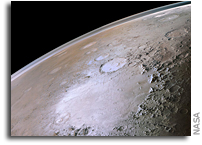Meteorite Reveals Mars Had a Dense Atmosphere 4 Billion Years Ago

Researchers have performed numerical simulations and compared the results to the composition of the ancient Martian atmosphere trapped in an old meteorite. The researchers have concluded that, 4 billion years ago, Mars had a dense atmosphere whose surface pressure was higher than 0.5 bar (50000 Pa).
This suggests that the processes to remove the Martian atmosphere, for example stripping by the solar wind, are responsible for transforming Mars into the cold desert world it is today.
Background
Exploration missions have suggested that Mars once had a warm climate, which sustained oceans on its surface. To keep Mars warm requires a dense atmosphere with a sufficient greenhouse effect, while the present-day Mars has a thin atmosphere whose surface pressure is only 0.006 bar, resulting in the cold climate it has today. It has been a big mystery as to when and how Mars lost its dense atmosphere.
Methodology
An old meteorite has been known to contain the ancient Martian atmosphere. The researchers simulated how the composition of the Martian atmosphere changed throughout history under various conditions. By comparing the results to the isotopic composition of the trapped gas, the researchers revealed how dense the Martian atmosphere was at the time when the gas became trapped in the meteorite.
Overview of Research Achievement
The research team concluded that Mars had a dense atmosphere 4 billion years ago. The surface air pressure at the time was at least 0.5 bar and could have been much higher. Because Mars had its magnetic field about 4 billion years ago and lost it, the result suggests that stripping by the solar wind is responsible for transforming Mars from a warm wet world into a cold desert world.
Future Development
NASA’s MAVEN spacecraft is orbiting Mars to explore the processes that removed the Martian atmosphere. The Japan Aerospace Exploration Agency (JAXA) is planning to further observe the removal processes by the Martian Moons eXploration (MMX) spacecraft. These missions will reveal how the dense atmosphere on ancient Mars predicted in this study was removed over time.
Reference
Hiroyuki Kurokawa1 *, Kosuke Kurosawa2, Tomohiro Usui1,3, A Lower Limit of Atmospheric Pressure on Early Mars Inferred from Nitrogen and Argon Isotopic Compositions, Icarus, DOI: 10.1016/j.icarus.2017.08.020
Earth-Life Science Institute, Tokyo Institute of Technology
Planetary Exploration Research Center, Chiba Institute of Technology
Department of Earth and Planetary Sciences, Tokyo Institute of Technology
*Corresponding authors email: [email protected]
About Tokyo Institute of Technology
Tokyo Institute of Technology stands at the forefront of research and higher education as the leading university for science and technology in Japan. Tokyo Tech researchers excel in a variety of fields, such as material science, biology, computer science and physics. Founded in 1881, Tokyo Tech has grown to host 10,000 undergraduate and graduate students who become principled leaders of their fields and some of the most sought-after scientists and engineers at top companies. Embodying the Japanese philosophy of “monotsukuri,” meaning technical ingenuity and innovation, the Tokyo Tech community strives to make significant contributions to society through high-impact research. http://www.titech.ac.jp/english/
About ELSI
Launched in 2012, ELSI is one of Japan’s ambitious World Premiere International research centers, whose aim is to achieve progress in broadly inter-disciplinary scientific areas by inspiring the world’s greatest minds to come to Japan and work on the most challenging issues as a collaborative effort. ELSI’s primary aim is to address the co-origin and co-evolution of the Earth and life.
About WPI
The World Premier International Research Center Initiative (WPI) was launched in 2007 by the Ministry of Education, Culture, Sports, Science and Technology (MEXT) in a drive to build “globally visible” research centers in Japan. These institutes aim to boast a very high research standard and outstanding research environment that attracts frontline researchers from around the world to come and work in them. These centers are given a high degree of autonomy, allowing them to revolutionize conventional modes of research operation and administration in Japan.








